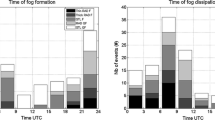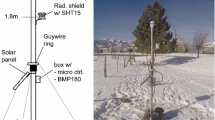Abstract
Observations from the Local and Non-local Fog EXperiment field campaign are used to investigate the formation and initial development of radiation fog. Data from six locations have been selected: five sites in Shropshire, and one in Bedfordshire, UK. These data show that during night-time clear-sky conditions, thermally-stable radiation fog only forms when the vertical velocity variance near the ground (at 2 m) decreases to 0.002–0.005 m2 s−2 or less. The variation in this threshold appears to be a function of the vertical relative humidity gradient near the ground. When the vertical velocity variance exceeds these values, saturation may still occur near the ground, but fog formation is inhibited due to the more efficient transport of moisture to the ground in the form of dew. Furthermore, once stable radiation fog forms, any increase in the vertical velocity variance to values greater than 0.002–0.005 m2 s−2 may cause the fog to dissipate. The subsequent development of shallow stable fog into deeper, weakly-unstable fog is also examined. Possible mechanisms for this are discussed, including in situ processes and non-local larger scale processes. Clear evidence of the latter is presented, but the relative importance of in situ and non-local processes for fog deepening requires further clarification.















Similar content being viewed by others
Notes
Other than deposition by hygroscopic absorption (Price and Clark 2014).
References
Agarwal M, Maze T, Souleyrette R (2005) Impact of weather on urban freeway traffic flow characteristics and facility capacity. Centre for Transportation Research and Education. http://www.ctre.iastate.edu/reports/weather_impacts.pdf. Accessed April 2016
Bartokova I, Bott A, Bartok J, Gera M (2015) Fog prediction for road traffic safety in a coastal desert region: improvement of nowcasting skills by the machine-learning approach. Boundary-Layer Meteorol 157:501–516. https://doi.org/10.1007/s10546-015-0069-x
Bergot T (2013) Small-scale structure of radiation fog: a large-eddy simulation study. Q J Roy Meteorol Soc 139:1099–1112. https://doi.org/10.1002/qj.2051
Bergot T, Escobar J, Masson V (2015) Effect of small-scale surface heterogeneities and buildings on radiation fog: large-eddy simulation study at Paris Charles de Gaulle airport. Q J Roy Meteorol Soc 141:285–298
Boutle I, Price J, Kudzotsa I, Kokkola H, Romakkaniemi S (2018) Aerosol-fog interaction and the transition to well-mixed radiation fog. Atmos Chem Phys 18:7827–7840. https://doi.org/10.5194/acp-18-7827-2018
Cuxart J, Jimenez MA (2012) Deep radiation fog in a wide closed valley: study by numerical modeling and remote sensing. Pure Appl Geophys 169:911–926
De Roode SR, Bosveld FC, Kroon PS (2010) Dew formation, eddy correlation, latent heat fluxes, and the surface energy balance. Boundary-Layer Meteorol 135:369–383. https://doi.org/10.1007/s10546-010-4476-1
Duynkerke PG (1999) Turbulence, radiation, and fog in Dutch stable boundary layers. Boundary-Layer Meteorol 90:447–477. https://doi.org/10.1023/A:1026441904734
Edwards JM (2009) Radiative processes in the stable boundary layer: part II. The development of the nocturnal boundary layer. Boundary-Layer Meteorol 131:127–146. https://doi.org/10.1007/s10546-009-9363-9
Gadher D, Baird T (2006) Airport dash as the fog lifts. The Sunday Times posted online 24 December 2006. https://www.thetimes.co.uk/article/airport-dash-as-the-fog-lifts-jtx5j5hxrnz
Garratt JR, Segal M (1988) On the contribution of atmospheric moisture to dew formation. Boundary-Layer Meteorol 45:209–236. https://doi.org/10.1007/BF01066671
Guedalia D, Bergot T (1994) Numerical forecasting of radiation fog. Part II: a comparison of model simulation with several observed fog events. Mon Weather Rev 122:1231–1246. https://doi.org/10.1175/1520-0493(1994)122%3c1231:NFORFP%3e2.0.CO;2
Gultepe I, Tardif R, Michaelides SC, Cermak J, Bott A, Bendix J, Muller MD, Pagowski M, Hansen B, Ellrod G, Jacobs W, Toth G, Cober SG (2007) Fog research: a review of past achievements and future perspectives. Pure Appl Geophys 164:1121–1159. https://doi.org/10.1007/s00024-007-0211-x
Gultepe I, Fernando HJS, Pardyjak ER, Hoch SW, Silver Z, Creegan E, Leo LS, Pu Z, De Wekker SFJ, Hang C (2016) An overview of the MATERHORN fog project: observations and predicability. Pure Appl Geophys 173:2983–3010. https://doi.org/10.1007/s00024-016-1347-0
Haeffelin M, Laffineur Q, Bravo-Aranda JA, Drouin MA, Casquero-Vera JA, Dupont JC, De Backer H (2016) Radiation fog formation alerts using attenuated backscatter power from automatic lidars and ceilometers. Atmos Meas Tech 9:5347–5365. https://doi.org/10.5194/amt-9-5347-2016
Hanish S, Lohney C, Buekert A (2015) Dewfall and its ecological significance in semi-arid coastal south-western Madagascar. J Arid Environ 121:24–31. https://doi.org/10.1016/j.jaridenv.2015.05.007
Herman GR, Schumacher RS (2016) Using reforecasts to improve forecasting of fog and visibility for aviation. Weather Forecast 31:467–482. https://doi.org/10.1175/WAF-D-15-0108.1
Maronga B, Bosveld FC (2017) Key parameters for the life cycle of nocturnal radiation fog: a comprehensive large-eddy simulation. Q J Roy Meteorol Soc 143:2463–2480. https://doi.org/10.1002/qj.3100
McCabe A, Swinbank R, Tennant W, Lock A (2016) Representing model uncertainty in the Met Office convection-permitting ensemble prediction system and its impact on fog forecasting. Q J Roy Meteorol Soc 142:2897–2910. https://doi.org/10.1002/qj.2876
Menut L, Mailler S, Dupont JC, Haeffelin M, Elias T (2014) Predictability of the meteorological conditions favourable to radiative fog formation during the 2011 ParisFog campaign. Boundary-Layer Meteorol 150:277–297. https://doi.org/10.1007/s10546-013-9875-1
Milmo D (2007) BAA counts the cost of December fog. Guardian Unlimited, posted 9 January 2007. www.guardian.co.uk/business/2007/jan/09/theairlineindustry.travel
Nakanishi M (2000) Large-eddy simulation of radiation fog. Boundary-Layer Meteorol 94:461–493. https://doi.org/10.1023/A:1002490423389
Pickering KE, Jiusto JE (1978) Observations of the relationship between dew and radiation fog. J Geophys Res 83:2430–2436
Pilie RJ, Mack EJ, Kocmond WC, Rogers CW, Eadie WJ (1975) The life cycle of valley fog. Part I: micrometeorological characteristics. J Appl Meteorol 14:347–363
Price JD (2011) Radiation fog. Part I: observations of stability and drop size distributions. Boundary-Layer Meteorol 139:167–191. https://doi.org/10.1007/s10546-010-9580-2
Price JD, Clark R (2014) On the measurement of dewfall and fog droplet deposition. Boundary-Layer Meteorol 152:367–393. https://doi.org/10.1007/s10546-014-9930-6.818
Price JD, Vosper S, Brown A, Ross A, Clark P, Davies F, Horlacher V, Claxton B, McGregor JR, Hoare JS, Jemmett-Smith B, Sheridan P (2011) COLPEX: field and numerical studies over a region of small hills. Bull Am Meteorol Soc 92:1636–1650. https://doi.org/10.1175/2011BAMS3032.1
Price JD, Lane S, Boutle IA, Smith DKE, Bergot T, Lac C, Duconge L, McGregor J, Kerr-Munslow A, Pickering M, Clark R (2018) LANFEX: a field and modelling study to improve our understanding and forecasting of fog. Bull Am Meteorol Soc 99:2061–2077. https://doi.org/10.1175/BAMS-D-16-0299.1
Price JD, Porson A, Lock A (2015) An observational case study of persistent fog and comparison with an ensemble forecast model. Boundary-Layer Meteorol 155:301–327. https://doi.org/10.1007/s10546-014-9995-2
Roach WT, Brown R, Caughey SJ, Garland JA, Readings CJ (1976) The physics of radiation fog: I—a field study. Q J Roy Meteorol Soc 102:313–333. https://doi.org/10.1002/qj.49710243204
Robinson PJ (1989) The influence of weather on flight operations at the Atlanta Hartsfield International Airport. Weather Forecast 4:461–468. https://doi.org/10.1175/1520-0434(1989)004%3c0461:TIOWOF%3e2.0.CO;2
Rodhe B (1962) The effect of turbulence on fog formation. Tellus 14:49–86. https://doi.org/10.1111/j.2153-3490.1962.tb00119.x
Rogers RR, Yau MK (1989) A short course in cloud physics, 3rd edn. Pergamon Press, Oxford. ISBN: 0-0705-3215-1
Román-Cascón C, Steeneveld GJ, Yagüe C, Sastre M, Arrillaga JA, Maqueda G (2016) Forecasting radiation fog at climatologically contrasting sites: evaluation of statistical methods and WRF. Q J Roy Meteorol Soc 142:1048–1063. https://doi.org/10.1002/qj.2708
Steeneveld GJ, Ronda RJ, Holtslag AAM (2015) The challenge of forecasting the onset and development of radiation fog using mesoscale atmospheric models. Boundary-Layer Meteorol 154:265–289. https://doi.org/10.1007/s10546-014-9973-8
Taylor GI (1917) The formation of mist and fog. Q J Roy Meteorol Soc 43:241–268
Tudor M (2010) Impact of horizontal diffusion, radiation and cloudiness parameterization schemes on fog forecasting in valleys. Meteorol Atmos Phys 108:57–70. https://doi.org/10.1007/s00703-010-0084-x
van der Velde IR, Steeneveld GJ, Schreur BGJW, Holtslag AAM (2010) Modeling and forecasting the onset and duration of severe radiation fog under frost conditions. Mon Weather Rev 138:4237–4253. https://doi.org/10.1175/2010mWR3427.1
Vautard R, Yiou P, van Oldenborgh GJ (2009) Decline of fog, mist and haze in Europe over the past 30 years. Nat Geosci 2:115–119. https://doi.org/10.1038/NGEO414
Von Glasow R, Bott A (1999) Interaction of radiation fog with tall vegetation. Atmos Environ 33:1333–1346
Vosper SB, Brown AR (2008) Numerical simulation of sheltering in valleys: the formation of nighttime cold-air pools. Boundary-Layer Meteorol 127:429–448. https://doi.org/10.1007/s10546-008-9272-3
Ye X, Wu B, Zhang H (2014) The turbulent structure and transport in fog layers observed over the Tianjin area. Atmos Res 153:217–234. https://doi.org/10.1016/j.atmosres.2014.08.003
Zhou B, Ferrier BS (2008) Asymptotic analysis of equilibrium in radiation fog. J Appl Meteorol Climatol 47:1704–1722. https://doi.org/10.1175/2007JAMC1685.1
Acknowledgements
I am very grateful to all of the people who made the LANFEX campaign possible, especially those staff at the Met Office Research Unit, Cardington. The comments of three anonymous reviewers are appreciated.
Author information
Authors and Affiliations
Corresponding author
Additional information
Publisher’s Note
Springer Nature remains neutral with regard to jurisdictional claims in published maps and institutional affiliations.
Electronic Supplementary Material
Below is the link to the electronic supplementary material.
10546_2019_444_MOESM1_ESM.wmv
Online Resource 1. This contains a thermal infra-red time-lapse video showing the evolution of fog during IOP 18. (WMV 4169 kb)
Rights and permissions
About this article
Cite this article
Price, J.D. On the Formation and Development of Radiation Fog: An Observational Study. Boundary-Layer Meteorol 172, 167–197 (2019). https://doi.org/10.1007/s10546-019-00444-5
Received:
Accepted:
Published:
Issue Date:
DOI: https://doi.org/10.1007/s10546-019-00444-5




